Page 414 of 476
414 5-2. Steps to take in an emergency
iQ_WE_74014ECheck the specified tire inflation pressure.
Tire inflation pressure is specified on the label on the driver’s side
pillar as shown. (P. 455)
Left-hand drive vehicles
Right-hand drive vehicles
Start the vehicle’s engine.
To inject the sealant and inflate
the tire, turn the compressor
switch on.
Page 415 of 476
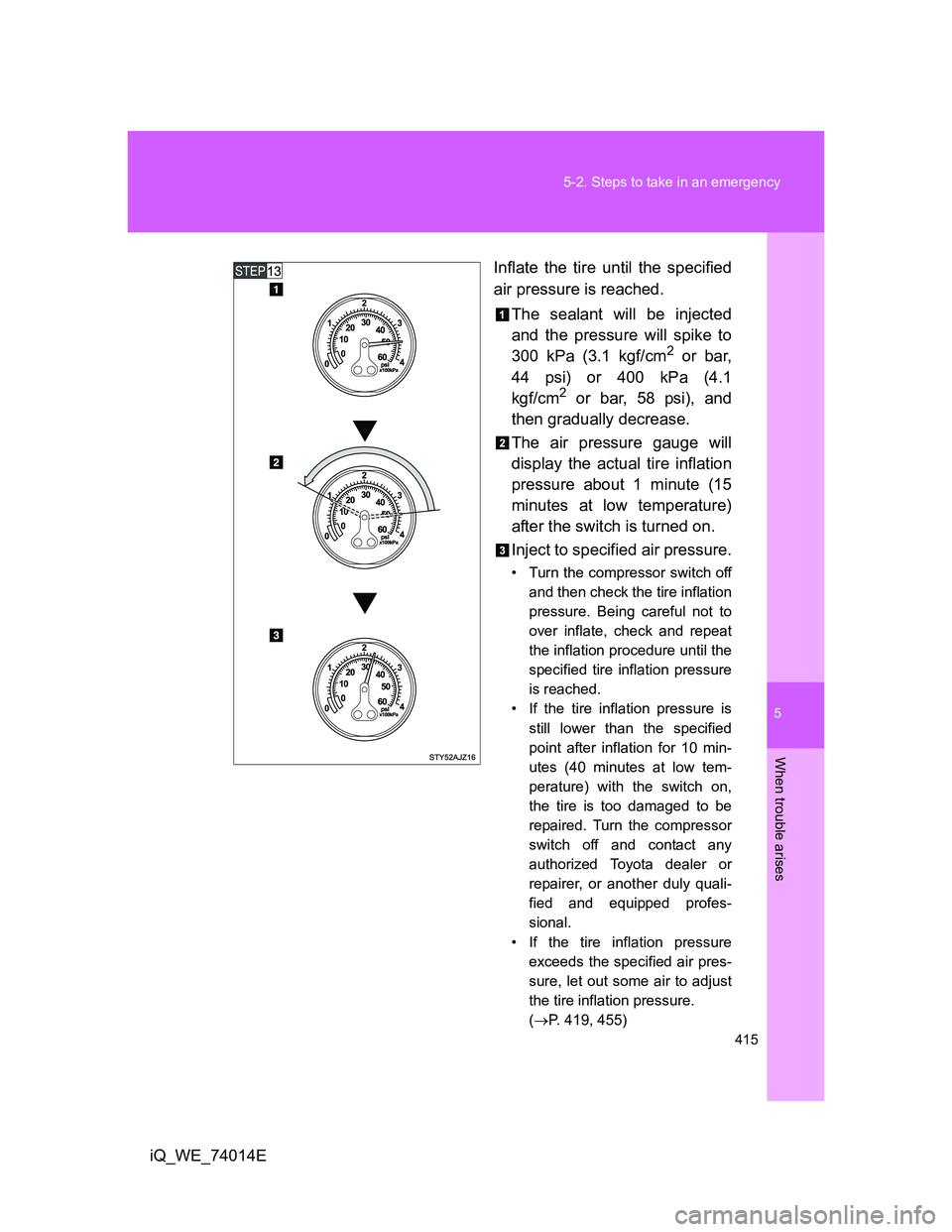
5
415 5-2. Steps to take in an emergency
When trouble arises
iQ_WE_74014EInflate the tire until the specified
air pressure is reached.
The sealant will be injected
and the pressure will spike to
300 kPa (3.1 kgf/cm
2 or bar,
44 psi) or 400 kPa (4.1
kgf/cm
2 or bar, 58 psi), and
then gradually decrease.
The air pressure gauge will
display the actual tire inflation
pressure about 1 minute (15
minutes at low temperature)
after the switch is turned on.
Inject to specified air pressure.
• Turn the compressor switch off
and then check the tire inflation
pressure. Being careful not to
over inflate, check and repeat
the inflation procedure until the
specified tire inflation pressure
is reached.
• If the tire inflation pressure is
still lower than the specified
point after inflation for 10 min-
utes (40 minutes at low tem-
perature) with the switch on,
the tire is too damaged to be
repaired. Turn the compressor
switch off and contact any
authorized Toyota dealer or
repairer, or another duly quali-
fied and equipped profes-
sional.
• If the tire inflation pressure
exceeds the specified air pres-
sure, let out some air to adjust
the tire inflation pressure.
(P. 419, 455)
Page 416 of 476
416 5-2. Steps to take in an emergency
iQ_WE_74014EWith the compressor switch off, disconnect the hose from the
valve on the tire and then pull out the power plug from the
power outlet socket.
Some sealant may leak when the hose is removed.
Install the valve cap onto the valve of the emergency repaired
tire.
Attach the air release cap to the
end of the hose.
If the air release cap is not
attached, the sealant may leak
and the vehicle may get dirty.
Temporarily store the bottle in the luggage room while it is
connected to the compressor.
To spread the liquid sealant evenly within the tire, immediately
drive safely for about 5 km (3 miles) below 80 km/h (50 mph).
After driving for about 5 km (3
miles), stop your vehicle in a
safe place on a hard, flat surface
and remove the air release cap
from the hose before reconnect-
ing the repair kit.
Page 417 of 476
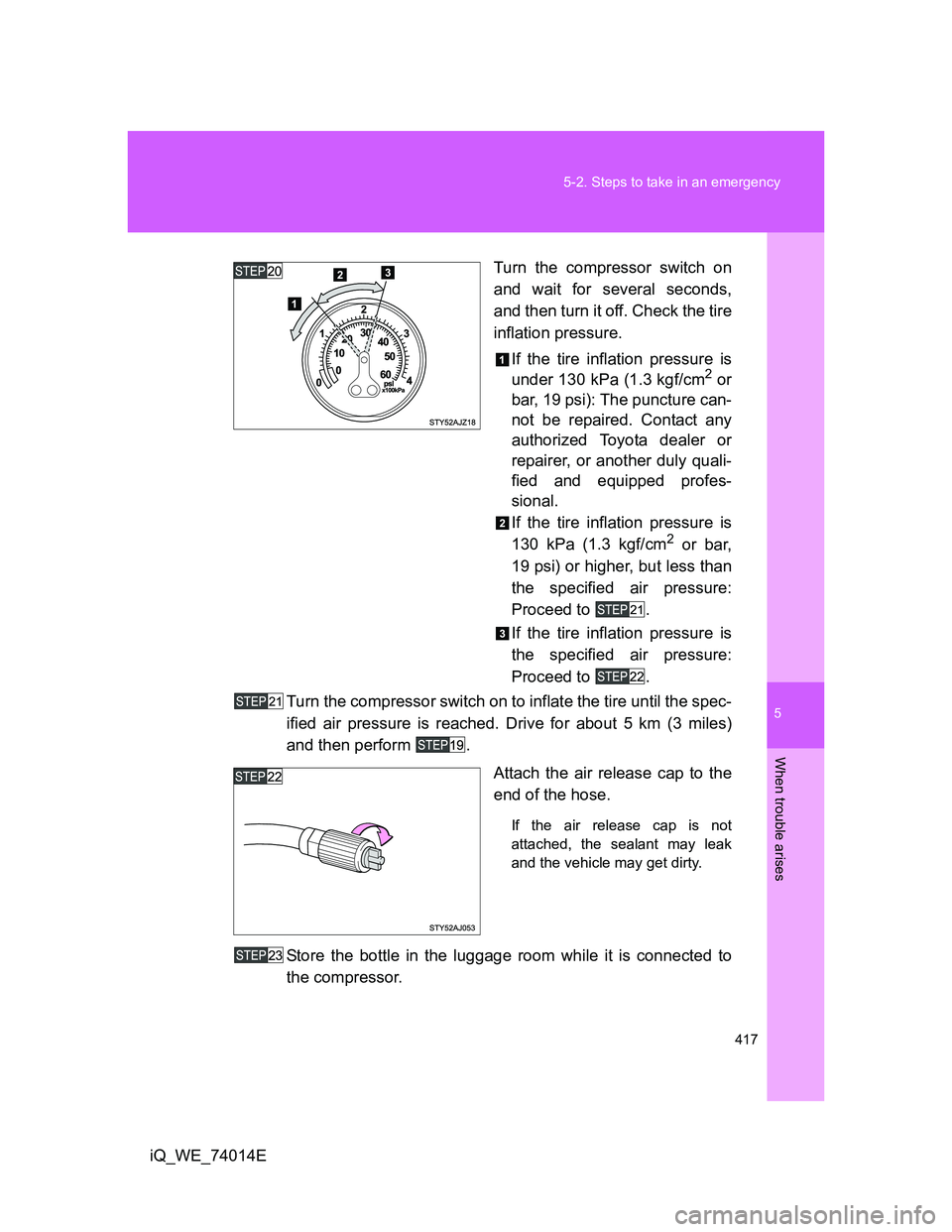
5
417 5-2. Steps to take in an emergency
When trouble arises
iQ_WE_74014ETurn the compressor switch on
and wait for several seconds,
and then turn it off. Check the tire
inflation pressure.
If the tire inflation pressure is
under 130 kPa (1.3 kgf/cm
2 or
bar, 19 psi): The puncture can-
not be repaired. Contact any
authorized Toyota dealer or
repairer, or another duly quali-
fied and equipped profes-
sional.
If the tire inflation pressure is
130 kPa (1.3 kgf/cm
2 or bar,
19 psi) or higher, but less than
the specified air pressure:
Proceed to .
If the tire inflation pressure is
the specified air pressure:
Proceed to .
Turn the compressor switch on to inflate the tire until the spec-
ified air pressure is reached. Drive for about 5 km (3 miles)
and then perform .
Attach the air release cap to the
end of the hose.
If the air release cap is not
attached, the sealant may leak
and the vehicle may get dirty.
Store the bottle in the luggage room while it is connected to
the compressor.
Page 419 of 476
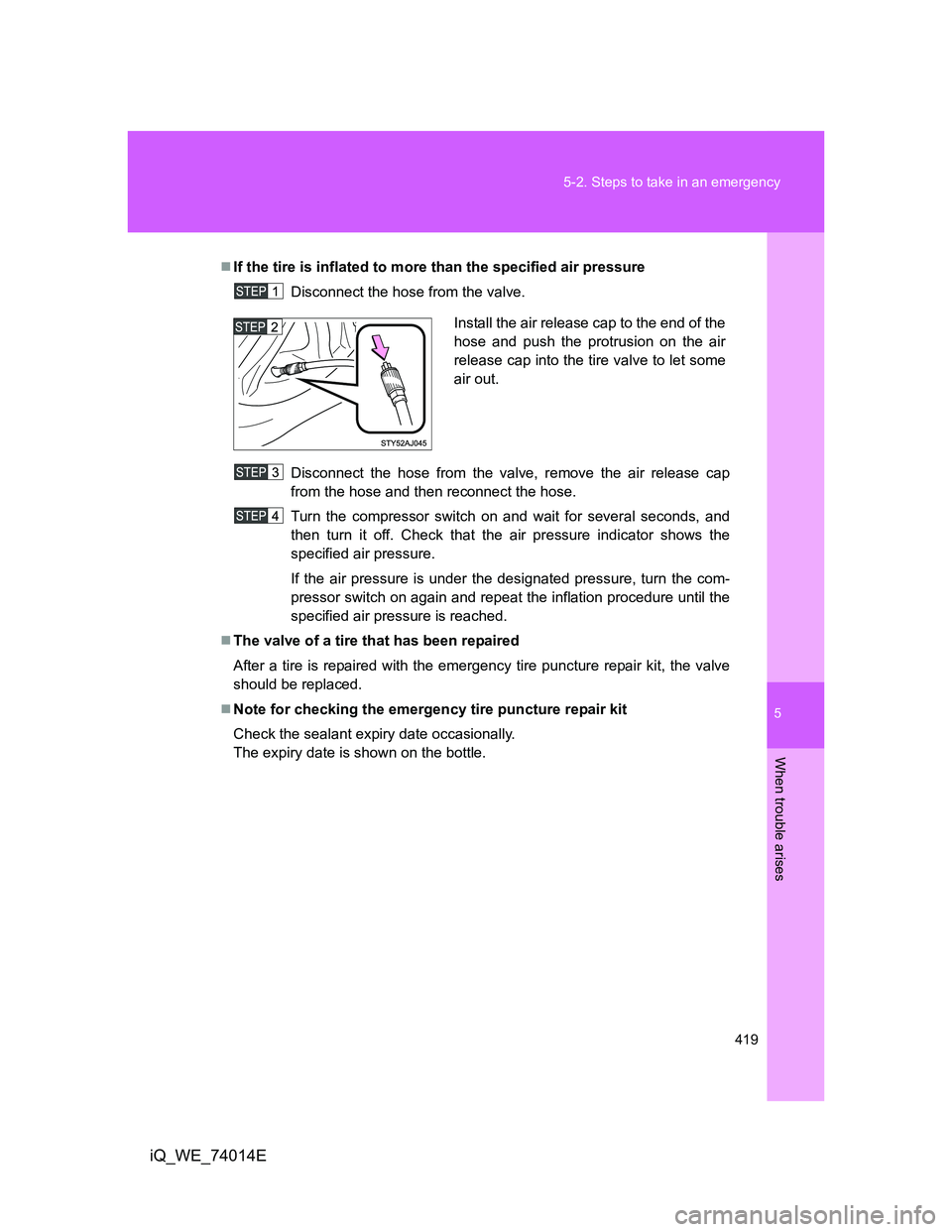
5
419 5-2. Steps to take in an emergency
When trouble arises
iQ_WE_74014E
If the tire is inflated to more than the specified air pressure
Disconnect the hose from the valve.
Disconnect the hose from the valve, remove the air release cap
from the hose and then reconnect the hose.
Turn the compressor switch on and wait for several seconds, and
then turn it off. Check that the air pressure indicator shows the
specified air pressure.
If the air pressure is under the designated pressure, turn the com-
pressor switch on again and repeat the inflation procedure until the
specified air pressure is reached.
The valve of a tire that has been repaired
After a tire is repaired with the emergency tire puncture repair kit, the valve
should be replaced.
Note for checking the emergency tire puncture repair kit
Check the sealant expiry date occasionally.
The expiry date is shown on the bottle.
Install the air release cap to the end of the
hose and push the protrusion on the air
release cap into the tire valve to let some
air out.
Page 420 of 476
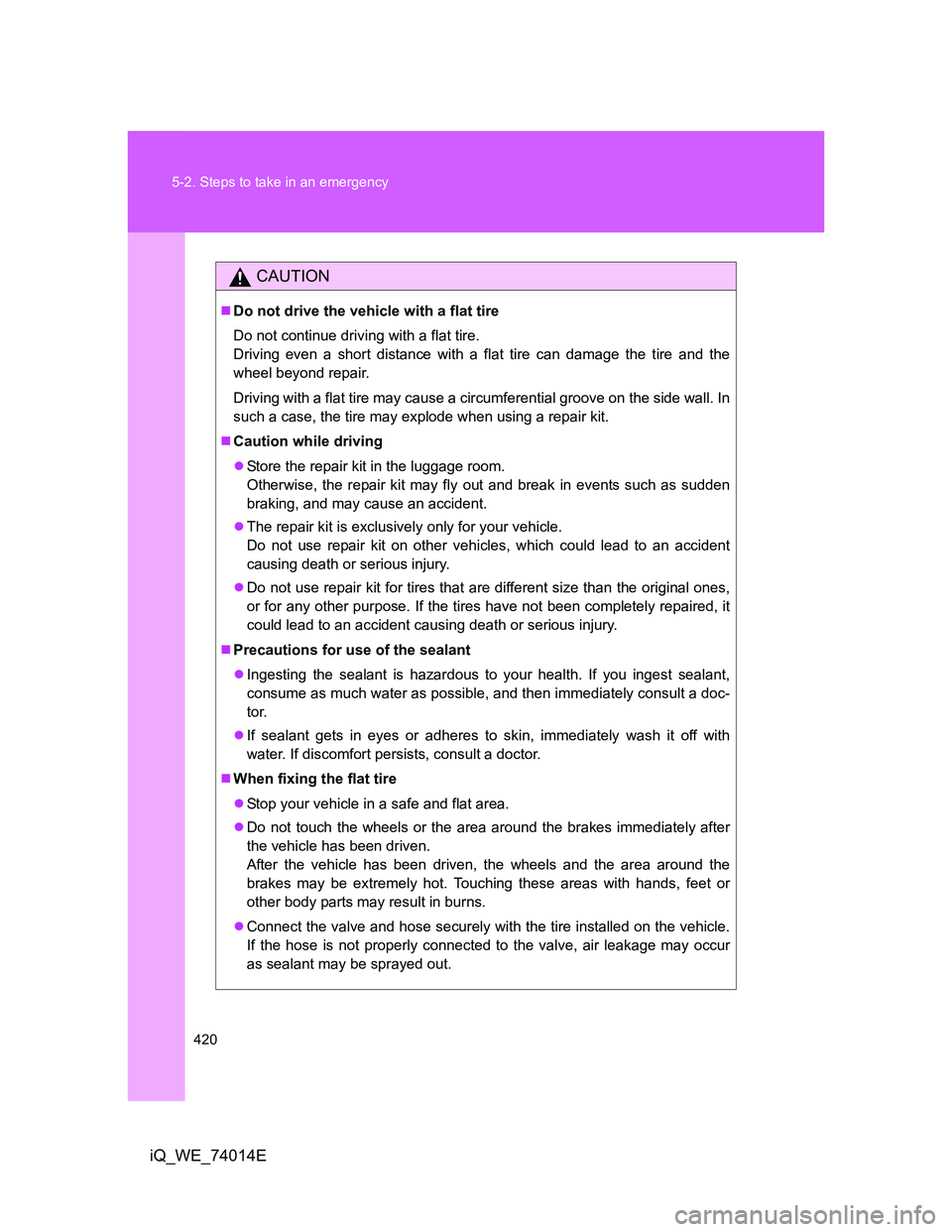
420 5-2. Steps to take in an emergency
iQ_WE_74014E
CAUTION
Do not drive the vehicle with a flat tire
Do not continue driving with a flat tire.
Driving even a short distance with a flat tire can damage the tire and the
wheel beyond repair.
Driving with a flat tire may cause a circumferential groove on the side wall. In
such a case, the tire may explode when using a repair kit.
Caution while driving
Store the repair kit in the luggage room.
Otherwise, the repair kit may fly out and break in events such as sudden
braking, and may cause an accident.
The repair kit is exclusively only for your vehicle.
Do not use repair kit on other vehicles, which could lead to an accident
causing death or serious injury.
Do not use repair kit for tires that are different size than the original ones,
or for any other purpose. If the tires have not been completely repaired, it
could lead to an accident causing death or serious injury.
Precautions for use of the sealant
Ingesting the sealant is hazardous to your health. If you ingest sealant,
consume as much water as possible, and then immediately consult a doc-
tor.
If sealant gets in eyes or adheres to skin, immediately wash it off with
water. If discomfort persists, consult a doctor.
When fixing the flat tire
Stop your vehicle in a safe and flat area.
Do not touch the wheels or the area around the brakes immediately after
the vehicle has been driven.
After the vehicle has been driven, the wheels and the area around the
brakes may be extremely hot. Touching these areas with hands, feet or
other body parts may result in burns.
Connect the valve and hose securely with the tire installed on the vehicle.
If the hose is not properly connected to the valve, air leakage may occur
as sealant may be sprayed out.
Page 421 of 476
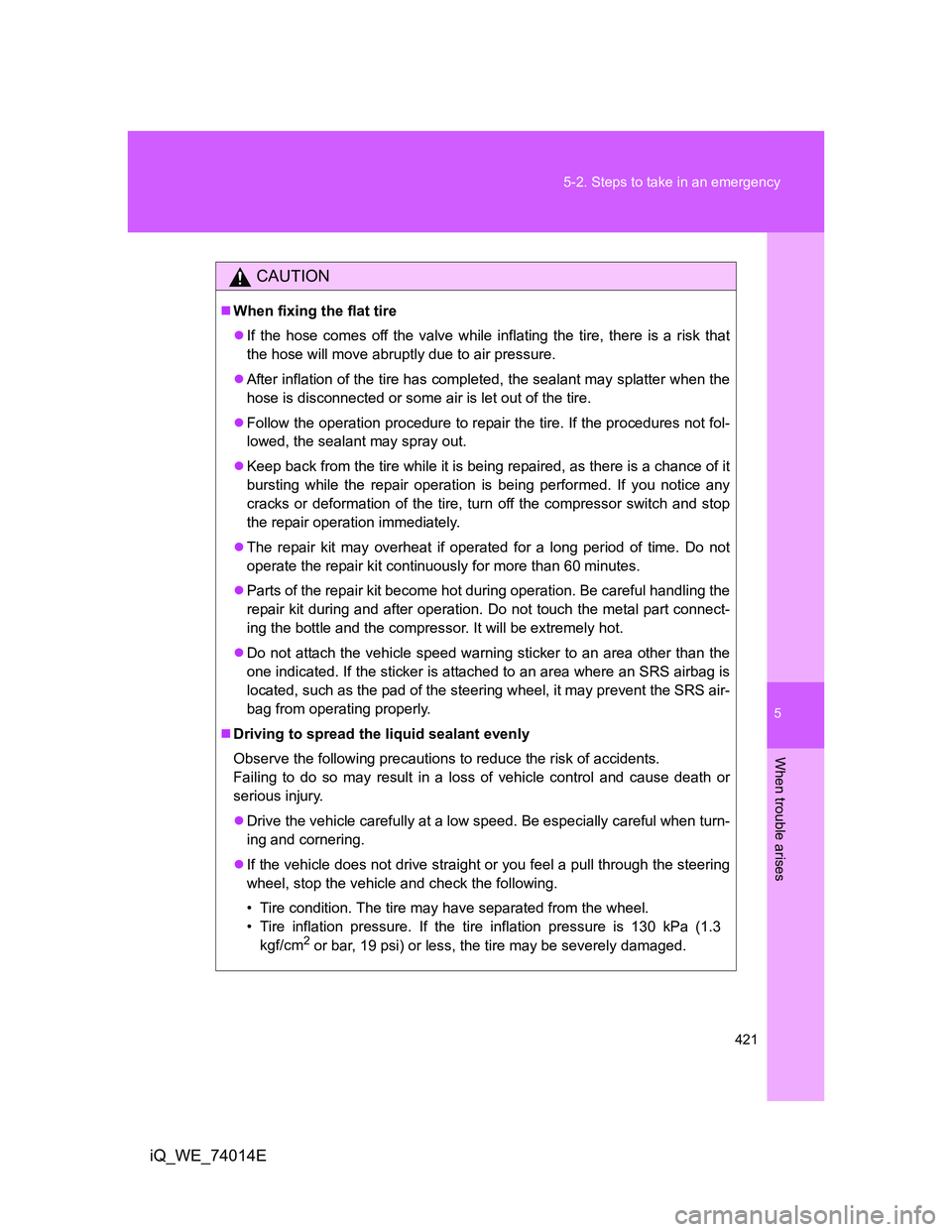
5
421 5-2. Steps to take in an emergency
When trouble arises
iQ_WE_74014E
CAUTION
When fixing the flat tire
If the hose comes off the valve while inflating the tire, there is a risk that
the hose will move abruptly due to air pressure.
After inflation of the tire has completed, the sealant may splatter when the
hose is disconnected or some air is let out of the tire.
Follow the operation procedure to repair the tire. If the procedures not fol-
lowed, the sealant may spray out.
Keep back from the tire while it is being repaired, as there is a chance of it
bursting while the repair operation is being performed. If you notice any
cracks or deformation of the tire, turn off the compressor switch and stop
the repair operation immediately.
The repair kit may overheat if operated for a long period of time. Do not
operate the repair kit continuously for more than 60 minutes.
Parts of the repair kit become hot during operation. Be careful handling the
repair kit during and after operation. Do not touch the metal part connect-
ing the bottle and the compressor. It will be extremely hot.
Do not attach the vehicle speed warning sticker to an area other than the
one indicated. If the sticker is attached to an area where an SRS airbag is
located, such as the pad of the steering wheel, it may prevent the SRS air-
bag from operating properly.
Driving to spread the liquid sealant evenly
Observe the following precautions to reduce the risk of accidents.
Failing to do so may result in a loss of vehicle control and cause death or
serious injury.
Drive the vehicle carefully at a low speed. Be especially careful when turn-
ing and cornering.
If the vehicle does not drive straight or you feel a pull through the steering
wheel, stop the vehicle and check the following.
• Tire condition. The tire may have separated from the wheel.
• Tire inflation pressure. If the tire inflation pressure is 130 kPa (1.3
kgf/cm
2 or bar, 19 psi) or less, the tire may be severely damaged.
Page 455 of 476

455 6-1. Specifications
6
Vehicle specifications
iQ_WE_74014E
Brakes
*1: Minimum pedal clearance when depressed with a force of 300 N (30 kgf, 66
lbf) while the engine is running
*2: Parking brake lever travel when pulled up with a force of 200 N (20 kgf, 44
lbf)
Steering
Tires and wheels
Pedal clearance*1
Vehicles with rear drum brake
Vehicles with rear disc brake91 mm (3.58 in.) Min.
86 mm (3.39 in.) Min.
Pedal free play 1 6 mm (0.04 0.24 in.)
Parking brake lever travel*2
Vehicles with rear drum brake
Vehicles with rear disc brake6 9 clicks
5 8 clicks
Fluid type SAE J1703 or FMVSS No.116 DOT 3
Free play Less than 30 mm (1.2 in.)
Tire size 175/65R15 84S, 175/60R16 82H
Tire inflation pressure
(Recommended cold tire
inflation pressure)Vehicle
speedFront wheel
kPa (kgf/cm
2
or bar, psi)Rear wheel
kPa (kgf/cm2
or bar, psi)
More than
160 km/h
(100 mph)240 (2.4, 35) 230 (2.3, 33)
160 km/h
(100 mph)
or less230 (2.3, 33) 220 (2.2, 32)
Wheel size 15 5 J, 16 5 J
Wheel nut torque 103 N·m (10.5 kgf·m, 76 ft·lbf)